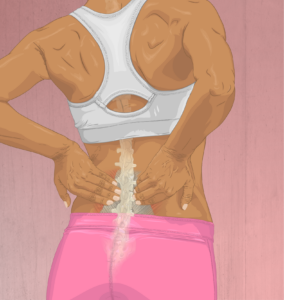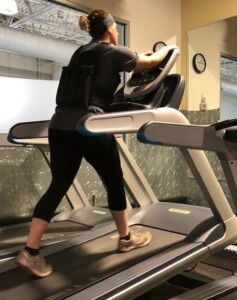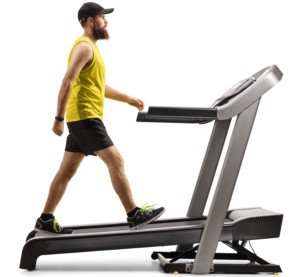
Find out the cause and solutions to low back pain from using a treadmill incline.
Have you noticed that using an incline on a treadmill triggers low back pain or an ache?
There’s a reason why using an incline on a treadmill is uncomfortable for your lower back.
This article is about low back pain that results from de-conditioning or poorly trained, weak soft tissue of the low spinal region.
If you have sharp, shooting pains in your low back, this needs medical evaluation for a nerve related problem.
Most low back pain is caused by under-exercising the muscles in this area, especially in combination with poor biomechanics in daily life such as picking something heavy off the floor with your back rather than legs.
Low Back Pain when Using Treadmill Incline

The low back pain comes from weak, out-of-shape muscles; these muscles are part of the core, which includes the erector spinae muscles.
The erector spinae’s job is to stabilize the spine, which includes the task of keeping it upright.
When you use the treadmill’s incline without holding onto the machine, these low back muscles are put into action:
They work hard to keep you erect, to keep you from falling off the tread.
Walking an incline isn’t just leg work. It is core work.
Believe it or not, the abs get engaged, too, as long as you’re NOT holding onto the machine.
Problem is, the vast majority of people hold on when using an incline.
I’ve been told by some of them it’s because their low back “hurts” when they let go of the treadmill.
To them, the smart thing to do is to simply hold on to ward off low back discomfort. But this is a big mistake.
Solution to Low Back Pain on Treadmill Incline

Shutterstock/Ljupco Smokovski
The solution is to let go of the machine, but at a pace that you can handle without struggling to keep up with the tread.
The “hurt” in an otherwise normal back (the assumption is that there’s no herniated disc, slipped disc or nerve impingement) comes from fatiguing muscles.
Muscles are supposed to “hurt” when you exercise them.
This is a good kind of pain that’s in the muscle, not the joint.
When muscles are worked and begin fatiguing, they’re not supposed to feel comfortable.
If you were to avoid exercise because it “hurts” your muscles, you’d never do any exercise.
Walking on a treadmill incline, without holding on, exercises the low back.
If it hurts, this is the same discomfort mechanism that occurs when, for example, your shoulders “hurt” when pushing dumbbells over your head.
The low back muscles absorb forces when you use an incline without holding onto the treadmill.
Do not give in to holding on to alleviate this discomfort any more than you’d avoid shoulder exercises to prevent your shoulder muscles from hurting (if the joint hurts, stop).
Again, this all assumes your lower spinal region is otherwise normal: no bone or nerve problems.
To strengthen your shoulders, you force yourself to tolerate the muscle burn.
To strengthen your legs, you force yourself to endure the muscle burn when doing walking lunges or squats.
Same thing applies to the low back: To strengthen these muscles, you must force yourself to endure the aching, which is actually the muscle burn of the erector spinae: Keep your hands off the treadmill.
This doesn’t mean you must do a marathon incline session.
Work the incline, hands off, for five minutes, then go back to zero incline and continue walking with an arm swing. Don’t hold on.
When the burn subsides, go back to incline use for a few minutes or so.
Introduce your erector spinae muscles to exercise intermittently, interval-style.
It may take a few weeks for the lower back muscles to adapt and no longer “hurt” when you use an incline.
Start off with a small incline, just like you’d start out with light dumbbells when doing shoulder presses for the first time.
Though weak shoulders or weak thigh muscles don’t typically hurt, it’s a fact that weak low back muscles tend to cause pain or aching.
Remember, holding onto a treadmill when using the incline greatly cheats the low back muscles from getting stronger, and puts you at risk for increased pain in this area.
 Lorra Garrick is a former personal trainer certified through the American Council on Exercise. At Bally Total Fitness she trained women and men of all ages for fat loss, muscle building, fitness and improved health.
Lorra Garrick is a former personal trainer certified through the American Council on Exercise. At Bally Total Fitness she trained women and men of all ages for fat loss, muscle building, fitness and improved health.
.


























